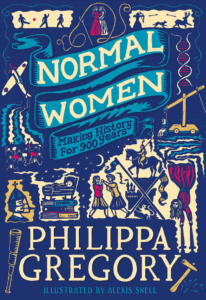Philippa Gregory, Normal Women: Making History for 900 Years, HarperCollins, March 2025, 288 pp., RRP $22.99 (pbk), ISBN 9780008725075
Historical writer Philippa Gregory has condensed her original 600-plus page tome about the treatment of ordinary women through British history into this visually easier to follow version for tweens and young adults.
Beginning with the women who crafted the Bayeux Tapestry, the epic embroidered canvas depicting the Anglo-Saxons’ loss to the Normans at the Battle of Hastings in 1066, Gregory whizzes us through 900 years of patriarchal injustice to women: from being written out of history entirely to denial of rights, including – crucially – economic rights.
This is a broad brush-stroke nod to ordinary women who became leaders, warriors, businesswomen, artists, even accomplished criminals during their lifetimes. It shows how ordinary women lived and loved, broke societal conventions and rules, became mistresses of their own destinies and carved their own pathways. It also shows how British society, through different historical epochs, treated women in general, and structured the expectations projected onto them on how to behave and be. The fact that Gregory has found so many normal women from all backgrounds doing extraordinary things despite such expectations is therefore both fascinating and enlightening.
Of course, in covering so large a period of historical time in a mere few hundred pages, Gregory manages only to cursorily sketch the many women whose intriguing lives she features here. Many personal stories seem frustratingly unfinished therefore, as if the official record of what happened to them ended suddenly, without explanation.
As for readership, I can imagine an educational readership for the book at private girls’ schools, but unfortunately I don’t foresee teen Aussie boys reading Normal Women for its own sake, nor for the useful information it would give them about societal constructs. Nor can I see a general Australian readership for the book unless they have British roots or are into British history.
Normal Women has been artfully illustrated throughout (by Alexis Snell) and there is pithy commentary about the rightness or (usually) wrongness of a particular decision or position. As an information book, Gregory’s extensive, formidable research is on full display for all young would-be historians, researchers and educators, however they identify; and there is a useful list of further reading suggestions at book’s end.
Reviewed by Suzanne Ingelbrecht





